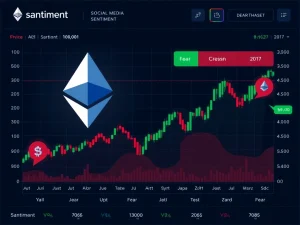ETF Crypto Market: Strategic Rebalancing Unlocks New Opportunities in a Post-Bitcoin Dominance Era

The cryptocurrency world is in the midst of a profound transformation. For years, Bitcoin stood as the undisputed titan, commanding the lion’s share of institutional and retail investor attention. It was the benchmark, the entry point, and often, the entire portfolio for many venturing into digital assets. However, 2025 marks a pivotal turning point, ushering in a new era for the ETF Crypto Market. We’re witnessing a dramatic reversal: Ethereum has, for the first time in over two years, surpassed Bitcoin in ETF inflows. This isn’t just a fleeting trend; it signals a maturing market and a strategic reallocation of capital towards growth-oriented crypto assets. This article will explore the forces driving this significant shift, the implications for Ethereum’s trajectory, and how investors can leverage smart diversification and rebalancing to thrive in a post-Bitcoin dominance landscape.
The Great Reallocation: Understanding the ETF Crypto Market Shift
The numbers speak volumes. In Q2 2025, Ethereum ETFs captured a staggering $6.2 billion in net inflows, significantly outpacing Bitcoin’s $2.2 billion. This isn’t merely a change in preference; it reflects a broader recalibration of investor priorities within the ETF Crypto Market. While Bitcoin steadfastly holds its position as the largest crypto asset by market cap, its price has consolidated, hovering between $100,000 and $107,000 since early 2025. For investors primarily seeking aggressive growth, this stability, while comforting, offers limited upside.
Conversely, Ethereum’s price surged past $3,500, fueled by robust institutional adoption of its smart contract ecosystem, groundbreaking Layer 2 scalability solutions, and attractive yield-bearing applications like staking and Decentralized Finance (DeFi). BlackRock’s Q2 data further underscores this trend, revealing that a remarkable 40% of its $14.1 billion digital asset inflows were specifically allocated to Ethereum-based products. By June 2025, Ethereum accounted for 50% of total crypto ETP inflows, a stark contrast to Bitcoin’s 65% share in early 2025. This reallocation has been amplified by favorable macroeconomic factors, including signals from the Federal Reserve regarding potential rate cuts and the landmark passage of the GENIUS Act, which has provided a much-needed regulatory framework for institutional-grade crypto custody and ETF approvals.
Beyond Bitcoin Dominance: The Rise of Ethereum ETF Inflows
Ethereum’s resurgence is far from accidental; it’s the culmination of years of development and strategic positioning. The network’s successful transition to a proof-of-stake (PoS) model in 2022, coupled with relentless innovation in Layer 2 (L2) solutions like Arbitrum and Optimism, has cemented its role as the foundational backbone of Web3. These advancements have unlocked an array of new and compelling use cases, including tokenized real-world assets (RWAs), a burgeoning Decentralized Finance (DeFi) sector, and cutting-edge AI-driven blockchain applications. The increasing Ethereum ETF Inflows are a direct reflection of this growing utility and perceived value.
For investors, Ethereum’s utility-driven growth model presents a compelling contrast to Bitcoin’s established role as a digital store of value. While Bitcoin’s appeal is rooted in its scarcity and potential as a macroeconomic hedge, Ethereum offers a dynamic, evolving platform for innovation and utility. This duality is crucial for effectively rebalancing portfolios in a maturing market: Bitcoin provides a foundational layer of stability, while Ethereum offers diversified growth opportunities driven by its ecosystem’s expansion. Moreover, Ethereum’s ecosystem has attracted over $6.2 billion in net inflows into Layer 2 platforms in 2025 alone. These platforms dramatically reduce transaction costs and enhance scalability, making Ethereum more accessible and appealing to a broader audience, including institutional players. Consequently, institutions are increasingly viewing Ethereum not just as an asset, but as a gateway to the next wave of blockchain innovation, further fueling Ethereum ETF Inflows.
Strategic Crypto Market Rebalancing: Your Blueprint for Growth
The clear shift from Bitcoin to Ethereum highlights the critical importance of actively rebalancing crypto portfolios to align with evolving market dynamics. Neglecting this can lead to missed opportunities or overexposure to stagnant assets. Here are three key strategies for investors to implement effective Crypto Market Rebalancing:
ETFs as a Hedging Tool and Growth Vehicle
Ethereum ETFs have rapidly emerged as an indispensable tool for diversification and gaining exposure to growth. These regulated products offer enhanced liquidity, significantly reduce counterparty risks, and allow investors to gain exposure to Ethereum’s potential without the complexities of direct asset ownership. With U.S. investors already holding over $27 billion in Bitcoin ETFs as of 2024, the rapid growth of Ethereum ETFs in 2025 is a logical and natural progression. Institutions, in particular, are drawn to their regulatory clarity and the ease with which they can be integrated into traditional investment portfolios, making them central to any Crypto Market Rebalancing strategy.
Sector-Based Diversification Beyond the Giants
Beyond the primary assets like Bitcoin and Ethereum, savvy investors should consider diversifying across various crypto sectors. Decentralized Finance (DeFi), Non-Fungible Tokens (NFTs), and foundational blockchain infrastructure projects are prime candidates for capital allocation. For instance, DeFi protocols offer innovative yield-generating opportunities through lending, borrowing, and liquidity provision, while NFTs cater to the burgeoning digital assets and creator economy. By strategically spreading capital across these diverse sectors, investors can mitigate the risk of overexposure to any single asset or specific use case, thereby enhancing their overall portfolio resilience.
Geographic and Derivative Hedging for Risk Management
Geographic diversification—investing in projects and protocols across different regions—can provide a crucial buffer against localized regulatory risks or adverse market conditions. Additionally, derivatives such as futures and options offer sophisticated tools to hedge against price volatility and manage risk. For instance, establishing long Ethereum futures positions can help lock in gains during pronounced bullish phases, while carefully constructed options strategies can provide robust protection against potential downside risk, ensuring more controlled participation in the market’s swings.
Unlocking Digital Asset Diversification: A New Paradigm
The current market landscape emphasizes that true Digital Asset Diversification extends far beyond simply holding Bitcoin and Ethereum. As the crypto ecosystem matures, new sectors, use cases, and technological advancements emerge, creating a rich tapestry of investment opportunities. A well-diversified portfolio in this new era should consider:
- DeFi Protocols: Explore established and emerging DeFi platforms offering staking, lending, and yield farming opportunities. Look for audited, secure protocols with strong community support.
- Layer 2 Solutions: Invest in the native tokens of prominent Layer 2 networks built on Ethereum, as they are integral to scaling the ecosystem and reducing transaction costs.
- Real-World Assets (RWAs) Tokenization: Projects focusing on bringing traditional assets like real estate, commodities, or even intellectual property onto the blockchain represent a significant growth area for Digital Asset Diversification.
- Gaming & Metaverse Tokens: The intersection of blockchain with gaming and virtual worlds is expanding rapidly, offering unique investment profiles.
- Privacy Coins & Decentralized Storage: Consider assets that address specific market needs like enhanced privacy or decentralized data storage, providing utility beyond mere speculation.
This broader approach to Digital Asset Diversification helps to capture growth from various fronts while simultaneously spreading risk, making your portfolio more robust against sector-specific downturns.
The Regulatory Catalyst: Fueling Institutional Confidence
Regulatory clarity has been a pivotal force in driving this significant market rotation and fostering institutional confidence. The passage of the GENIUS Act in the U.S. and Europe’s comprehensive MiCA (Markets in Crypto-Assets) framework have provided institutional investors with the much-needed legal certainty and operational guidelines to confidently allocate substantial capital to crypto assets. This newfound clarity addresses previous concerns regarding compliance, custody, and market manipulation, paving the way for broader adoption.
Surveys indicate a dramatic shift in institutional sentiment: over 75% of institutional investors now plan to increase their crypto allocations in 2025, with many targeting 5% or more of their Assets Under Management (AUM) in digital assets. This isn’t merely speculative interest; it reflects a growing recognition of crypto’s legitimate role in modern portfolio theory as a non-correlated asset class. The ability of digital assets to potentially offer returns independent of traditional markets makes them attractive for enhancing portfolio efficiency and reducing overall risk, further solidifying the case for strategic Crypto Market Rebalancing.
Navigating the Future: Investment Advice for a Maturing Market
For investors seeking to capitalize on this profound transition and effectively navigate the evolving digital asset landscape, the following steps are highly recommended:
- Rebalance Towards Ethereum-Based Exposure: Given the significant shift in inflows, strategically allocate a larger portion of your crypto holdings to Ethereum ETFs, native Layer 2 platform tokens, and well-vetted DeFi protocols. This positions your portfolio to benefit from Ethereum’s utility-driven growth.
- Diversify Across Sectors and Geographies: Avoid overconcentration in Bitcoin or any single sector. Actively research and consider altcoins with strong fundamentals, clear utility, and robust development teams. Explore emerging markets with supportive regulatory environments, as they may offer unique growth opportunities. This reinforces effective Digital Asset Diversification.
- Leverage Derivatives for Risk Management: Incorporate options and futures into your strategy to hedge against market volatility. These tools can help protect against significant downside risk while still allowing you to maintain exposure to growth assets during upward trends.
- Monitor Macro Trends and Regulatory Updates: Stay constantly attuned to global macroeconomic factors, particularly central bank policies and interest rate signals, as these heavily influence investor sentiment. Equally important is keeping abreast of new regulatory developments worldwide, which will continue to shape the institutional adoption and overall market structure of digital assets.
Conclusion
The rotation of capital from Bitcoin to Ethereum marks a pivotal and exciting moment in the crypto market’s evolution. As institutional adoption accelerates and regulatory frameworks solidify globally, the primary focus is unequivocally shifting from purely speculative trading to sophisticated, strategic portfolio construction. By thoughtfully rebalancing towards Ethereum’s vibrant, growth-oriented ecosystem and meticulously diversifying across various sectors, investors can strategically position themselves to not only survive but thrive in a dynamic post-Bitcoin Dominance Shift era. The key to long-term success lies in achieving a prudent balance between Bitcoin’s foundational stability and Ethereum’s boundless innovation—and in doing so, capturing the full, transformative potential of a truly maturing digital asset market.
Frequently Asked Questions (FAQs)
Q1: What is the primary driver behind the shift in ETF inflows from Bitcoin to Ethereum?
The primary driver is a recalibration of investor priorities. While Bitcoin has consolidated as a store of value, Ethereum’s utility-driven growth, fueled by its smart contract ecosystem, Layer 2 scalability solutions, and yield-bearing applications like DeFi, offers greater upside potential for growth-oriented investors. Regulatory clarity and institutional adoption of Ethereum’s ecosystem also play a significant role.
Q2: How does the GENIUS Act impact institutional investment in the crypto market?
The GENIUS Act provides a clear regulatory framework for institutional-grade crypto custody and ETF approvals in the U.S. This legal certainty significantly reduces compliance risks and operational ambiguities for large financial institutions, making them more confident in allocating capital to digital assets, thereby fueling market growth and strategic rebalancing.
Q3: What are Layer 2 solutions, and why are they important for Ethereum’s growth?
Layer 2 (L2) solutions are scaling technologies built on top of the Ethereum blockchain (e.g., Arbitrum, Optimism). They process transactions off-chain, significantly reducing transaction costs and increasing throughput. This enhanced scalability makes Ethereum more efficient, accessible, and appealing for a broader range of applications and users, including institutional investors, thus driving its adoption and value.
Q4: Besides Bitcoin and Ethereum, what other sectors should investors consider for diversification?
Beyond Bitcoin and Ethereum, investors should consider diversifying into sectors such as Decentralized Finance (DeFi) for yield opportunities, Non-Fungible Tokens (NFTs) for exposure to the digital assets market, and foundational blockchain infrastructure projects. Exploring tokens related to tokenized real-world assets (RWAs), gaming, metaverse, and privacy solutions can also enhance portfolio resilience.
Q5: How can derivatives like futures and options be used in crypto portfolio rebalancing?
Derivatives like futures and options offer advanced tools for risk management. Long futures positions can help lock in gains during bullish phases, while options can provide downside protection against price volatility. They allow investors to hedge against market swings and manage exposure more precisely, complementing their long-term investment strategies.









